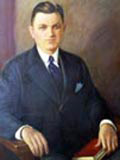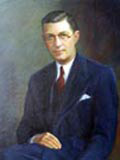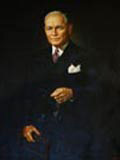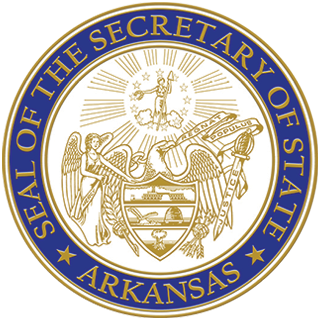State Governors 1933-1953
State Governors 1933-1953
Junius Marion Futrell
Born: August 14, 1870, at Jones Ridge, Arkansas
Died: June 20, 1955, at Little Rock, Arkansas
Buried: Linwood Cemetery, Paragould
Served: 1933-1937
Junius M. Futtrell attended the University of Arkansas from 1892 to 1893, studied law, and was admitted to the bar in 1913. In his early years Futrell taught school, farmed, and worked in the timber industry. In 1896 he was elected to the Arkansas House of Representatives and returned twice. He was elected clerk of the Circuit Court in 1906, and state senator in 1912, serving until 1917. In 1913 Governor Joseph T. Robinson resigned from office and Futrell, who was president of the Senate at the time, became acting governor. He served in this capacity until July 23, 1913. In 1922, he was appointed Circuit Court judge for the Second Judicial District, and then served as chancellor of the 12th District from 1923 to 1933. In 1932 Futrell was elected to a full term as Governor of Arkansas, and won a second term in 1934. During his tenure, the Refunding Act was enacted, the Arkansas Prohibition Act was rescinded, and the State Planning Board was established. In addition, the Arkansas Department of Public Welfare was created, pari-mutuel betting on dog and horse races was legalized and two amendments to the state constitution limiting the state's power to tax were adopted. After Futrell left office, he remained in Little Rock and returned to the practice of law.
Carl Edward Bailey
 Born: October 8, 1894, at Bernie, Missouri
Born: October 8, 1894, at Bernie, Missouri
Died: October 23, 1948, at Little Rock, Arkansas
Buried: Roselawn Memorial Park, Little Rock
Served: 1937-1941
Carl Bailey, a Missouri native, attended Chillicothe Business College in 1915 but never finished due to a shortage of funds. In 1917, Bailey moved to Arkansas where he worked as a bookkeeper while studying law. In 1923 he was admitted to the Arkansas Bar. Bailey served as deputy prosecuting attorney, then prosecuting attorney from 1927 to 1935. serving until 1935. He was elected attorney general of Arkansas in 1934, and governor in 1936. He won a second term in 1938. During his tenure, the Department of Public Welfare was restructured and Arkansas qualified for full participation in all federal welfare programs. A free library system was created and a retirement system was drafted. All state-owned bridges were made toll-free, and a new agricultural experiment station was established at Batesville. Bailey ran unsuccessfully for a third term, and left office on January 14, 1941. He later served as a legislative representative of the Brotherhood of Railway Trainmen and taught legal medicine at the University of Arkansas medical school.
Homer Martin Adkins
 Born: October 15, 1890, at Jacksonville, Arkansas
Born: October 15, 1890, at Jacksonville, Arkansas
Died: February 26, 1964, at Malvern, Arkansas
Buried: Roselawn Memorial Park, Little Rock
Served: 1941-1945
Arkansas's 32nd governor attended Draughon's Business College in 1908 and graduated from the Little Rock College of Pharmacy in 1911. At the age of 20, Adkins was licensed as a pharmacist, but needed special permission to practice because he was six months shy of the required age of 21. During World War I, he served in the army, was assigned to the medical corps, and later rose to the rank of captain. Adkins entered politics in 1923, when he served one term as sheriff of Pulaski County. He was appointed collector of internal revenue in 1933, and served until 1940 when he resigned to run for governor. Adkins was elected in that year and in 1942 won a second term. During his tenure, the state treasury surplus rose from $21 million to $45 million and the first workmen's compensation commission was appointed. The Grand River Dam in Oklahoma also was completed, which provided an enormous amount of much-needed electrical power to northeastern Arkansas. Adkins also campaigned to refinance the highway debt; Arkansas voters approved his refunding act in 1943. After leaving office Adkins was a political broker, consultant, and advisor to several politicians. In 1948, he was appointed administrator of the Arkansas Employment Security Division, and in 1956 he established a public-relations firm in Little Rock, in which he worked until shortly before his death in 1964.
Benjamin Travis Laney Jr.
 Born: November 25, 1896, at Jones Chapel (Cooterneck), Arkansas
Born: November 25, 1896, at Jones Chapel (Cooterneck), Arkansas
Died: January 21, 1977, at Magnolia, Arkansas
Buried: Camden Memorial Cemetery, Camden
Served: 1945-1949
"Business Ben" Laney, born in 1896, attended the public schools in Ouachita County. In 1918 he enlisted in the U.S. Navy and served until the Armistice; he earned a degree from the Arkansas Teachers College in 1924 and took graduate courses from the University of Utah. Laney owned a drugstore in Conway, Arkansas, traded in farm real estate and entered the oil business when oil was discovered on his family farm near Camden, Arkansas. He entered politics in 1935 when elected Mayor of Camden, serving until 1939. Laney ran for governor and won both the 1944 and 1946 elections. In his first campaign, Laney called for "efficiency, economy and consolidation" in state government; he followed through by promoting the ultimately adopted Revenue Stabilization Act which proved to be his greatest achievement. While Laney was governor, the Arkansas Resources and Development Commission was formed and the Corporation and Utilities Commissions were consolidated into the Public Service Commission. Also during his tenure, construction of both the War Memorial Stadium in Little Rock and the governor's mansion was authorized by the Assembly. Laney was a consistent supporter of racial segregation and eventually became identified with the "Dixiecrat" states' rights movement but, notably, during Laney's administration the University of Arkansas became the first historically white southern public university to admit African-American students. Laney did not seek re-election for a third term and left office on January 11, 1949. He ran, unsuccessfully, in the 1950 gubernatorial race but remained active in public affairs, serving as a delegate to the 1969 Arkansas Constitutional Convention.
Sidney Sanders McMath
 Born: June 14, 1912, in Columbia County, Arkansas
Born: June 14, 1912, in Columbia County, Arkansas
Died: October 4, 2003, at Little Rock, Arkansas
Buried: Pinecrest Memorial Park, Little Rock
Served: 1949-1953
Sid McMath graduated from the University of Arkansas in 1936 with a law degree. During World War II, he served in the U.S. Marine Corps and was awarded both the Silver Star and the Legion of Merit awards. McMath entered politics in 1947 and served one term as prosecuting attorney for Garland and Montgomery counties. In November 1948, McMath was elected governor and was re-elected in 1950. During his tenure, general-obligation bonds were authorized for the construction and maintenance of highways and bridges and a new medical center in Little Rock was planned. The state's mental health system was revised, the university's medical school was upgraded, and the minimum wage increased. McMath set a progressive tone in race relations by supporting a state anti-lynching law, sought repeal of the poll tax and appointed a number of blacks to previously all-white boards and commissions. During his second term McMath's enemies suggested that the governor was connected with irregularities in the management of the state's highways department. These charges were never proved but they had their effect: McMath lost his bid for re-election to a third term in 1952. He subsequently ran for the U.S. Senate in 1954, and again for governor in 1962, but was defeated in both races. He returned to his law practice and was elected president of the International Academy of Trial Lawyers in 1976. His death in 2003 coincided with the publication of his memoir, Promises to Keep.





